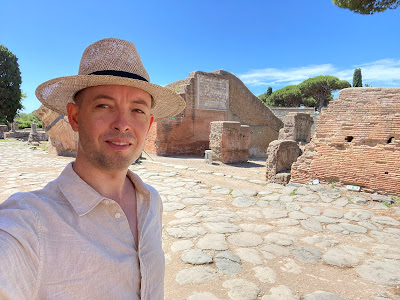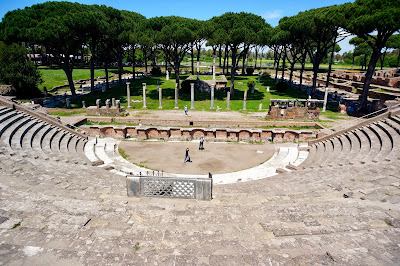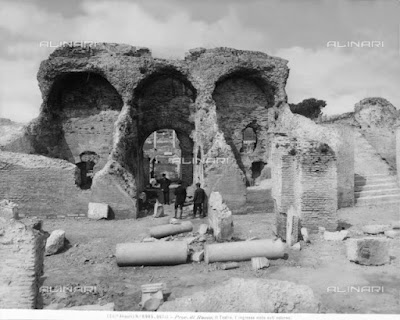I travelled to Rome again this summer to do some research, but this time not for my PhD. I'm a member in a research team at the Finnish Institute in Rome. My research in this project focuses on the theatre of Ostia, the ancient harbor town of Rome.
It felt odd to return to Rome after a year of being away. We spent the spring of 2020 at the institute with our team, and now we were all together again. This time, however, all the museums and libraries were open and we could move freely about the city. Now we could access those resources that we missed the last time because of the outbreak of the pandemic. So I headed to Ostia to see the excavations and visit the archives there.
 |
| Ostia in the summer of 2021. The theatre is in the background. |
The focus of my research is on the theatre of Ostia in Late Antiquity and Early Middle Ages. How long was the theatre maintained and the public spectacles offered at Ostia? What happened to the building after the spectacles ended? We know that the theatre was used for theatrical shows at least until the end of the fourth century CE. But what happened to the theatre after that? During the slow decline of Ostia the theatre fell into disrepair and collapsed at some point. Some of the material from the theatre was probably reused elsewhere. I've been looking for answers to these questions at the archives of Ostia.
 |
| The theatre of Ostia in 1894 (photo: British School at Rome, Thomas Ashby Collection, neg. 251) |
When the theatre was excavated in the late 19th and early 20th century all that was left was a heap of ruins. This can be seen in photos from the time of the excavations. The theatre in its present-day shape is the result of 20th century restorations. During these restorations many of the late antique and medieval structures were cleared away. Ancient materials were often used in the restorations which sometimes makes it difficult to tell which structures are original and which were restored.
 |
| The theatre of Ostia in 2018 |
This means that we have to search for the original appearance and the lost parts of theatre through archival research. Luckily, there are photos from the time of the excavations, which show much that was later removed or that is now hidden by the modern restorations.
Here is one example: There were originally two shops on either side of the central corridor of the theatre. In the fourth century CE these shops were converted into cisterns by closing the doorways with brick walls and adding waterproof mortar on the interior walls. Water contained in these cisterns could be led to a basin in the orchestra, where actors or dancers performed in water-themed spectacles.
 |
| The facade and the central corridor of the theatre in 1890 (photo: Archivio Alinari, ACA-F-006985-0000) |
The walls that closed off the shops and many other traces of the water spectacles were removed during the 20th century restorations. These walls can be seen in the photo above. Still visible in the theatre are the openings in the walls of the central corridor. Through these conduits the water was led into the corridor and from there to the orchestra.
Such photos from the time of the excavations at Ostia can be found in many archives in Italy and elsewhere. (A few links to online resources at the end of this article.) One of the most important ones is the photo archive at Ostia, which was one of my main destinations during my stay in Rome. It was a refreshing change to dig into the archival cabinets and leaf through the photo cards instead of just sitting at my computer. I had never been at the archive before, so I didn't really know whether I'd find anything that I hadn't already read about in other sources. Now I can say that much of what found will be useful for my research. You'll get to read more about it once my article is published.
 |
| At the photo archive of Ostia. |
When Dante Vaglieri was the director of the excavations at Ostia between 1908 and 1913 wide areas of the city were excavated, among them the rest of the theatre and its surroundings. (The interior and the scene of the theatre had been excavated during the 1880's.) Vaglieri's assistant Raffaele Finelli wrote detailed diaries of these excavations. With the help of the diaries we can follow the progression of the excavations and what was found almost day by day. These diaries (Giornali di scavo) are kept in the archives at Ostia where I got to study them.
These diaries make up one or two large volumes for each year. During the first few years the diaries were written by hand. The style of the handwriting varies – sometimes it changes in the middle of a paragraph – which means that it wasn't Finelli alone who wrote the diaries, but perhaps his assistants together with him. Later Finelli got a typewriter, which makes the task of a modern reader slightly easier.
 |
| Diary from 1910: date, number of workers, location, and a description of the excavations and finds. Click the image to enlarge. |
These diaries are mostly quite tedious to read, but there are some interesting details that tell us about the conditions at the excavations a hundred years ago. The diary entry from January 22nd 1910 (in the photo above) mentions that on that day the works were halted due to strong winds. At other times it was because of a heavy rain. On Saturday February 5th 1910 the workers were on strike because they weren't given a raise. The matter was settled the following day and the excavations continued. At times a lack of funds forced Vaglieri to lay off a large part of his workers. During some periods the excavations went on seven days a week, while sometimes it's mentioned that they didn't work on Sundays or on holidays.
I had time to study the diaries for just a few hours on one day. I went through and photographed as much as I could and read the material later. Reading the diaries it becomes clear just how badly the theatre was damaged in antiquity and during the Middle Ages. Most of the theatres decorations were gone and collapsed pieces of the theatre were found all around the theatre. Some of the bigger ones were left where they were found and where they can still be seen, but most of the material could not be salvaged and was cleared away.
 |
| A large piece of the theatre's facade, left where it was found during the excavations. |
The theatre was one of the most prominent buildings in Ostia and an essential part of the public life of the city. It still fascinates both tourists and scholars. My research is still unfinished and my search for the theatre in the archives will continue. I will travel to the Finnish Institute in Rome again next week to work on my PhD thanks to a one year long grant awarded by the Foundation Institutum Romanum Finlandiae together with Jenny and Antti Wihuri Foundation. This gives me the chance to continue my research on the theatre of Ostia as well.
Thank you to Parco Arceologico di Ostia Antica for giving me access to the archives, and to the staff for your guidance and help in finding the materials I was looking for.
Photos: Joonas Vanhala (unless otherwise noted)
Online collections with photos of the excavations at Ostia:
- American Academy in Rome: http://dhc.aarome.org
- Archivio Alinari: https://www.alinari.it/it/
- British School at Rome: https://www.bsrdigitalcollections.it
- Deutsches Archäologisches Institut: https://arachne.dainst.org
- ICCD: https://dati.beniculturali.it/applicazioni_/applicazione-fotografico/
- Ostia-antica.org, Virtual Museum: https://www.ostia-antica.org/vmuseum/vmuseum.htm
- Calza, G., Il teatro romano di Ostia, Rome, 1927. ostia-antica.org
- Cooley, A., "A new date for Agrippa's theatre at Ostia", Papers of the British School at Rome 67, 1999, 173–182.
- Gallico, S., "Il 'restauro' del teatro romano di Ostia Antica: Ideologia di un ripristino", in Saggi in onore di Gaetano Miarelli Mariani, ed. Sette et al., Rome, 2007, 511–520.
- Gering, A., Ostias vergessene Spätantike: Eine urbanistische Deutung zur Bewältigung von Verfall, Wiesbaden, 2018.
- On the theatre p. 87–106
- Gismondi, I., "La Colimbetra del teatro di Ostia", in Anthemon, Scritti in onore di Carlo Anti, Venice, 1954, 293–308. ostia-antica.org
- Meiggs, R., Roman Ostia, 2nd ed., Oxford, 1973. ostia-antica.org
- On the theatre p. 420–425
- Notizie degli Scavi di Antichità, ostia-antica.org
- On the theatre see especially volumes from 1880, 1881, 1910, 1911, 1912 and 1913. Specific pages can be found in the bibliography at ostia-antica.org under Lanciani and Vaglieri.
No comments:
Post a Comment